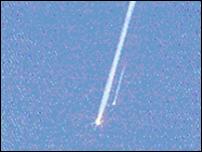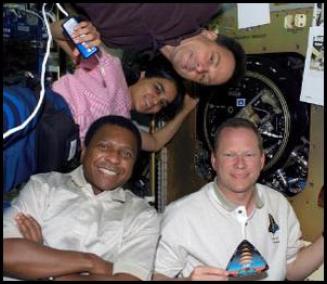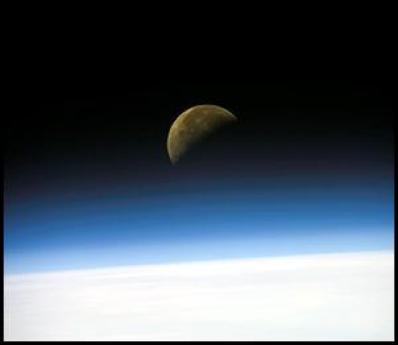United States Space Shuttle Columbia Explodes Over Texas
By The Scoop Editorial Team
 BREAKING NEWS:
NASA declared an emergency in the early hours of Sunday
morning New Zealand time after the space shuttle Columbia
exploded over Texas.
BREAKING NEWS:
NASA declared an emergency in the early hours of Sunday
morning New Zealand time after the space shuttle Columbia
exploded over Texas.
The Shuttle was on a descending heading toward Florida where it was scheduled to land at the Kennedy Space Station at 9:16am US-ESTime.
CNN has broadcast television pictures showing several streaks in the sky over Texas. The debris could be clearly seen from downtown Dallas.
NASA has yet to release information on the cause of the explosion, but has advised the US public to avoid any debris that may have come from the space shuttle. The Shuttle used toxic propellants as fuel.
NASA’s Entry Flight Director Leroy Cain declared a contingency for the shuttle Columbia at around 8:14 a.m. CST (02:14am NZ Time) as the shuttle and its seven astronauts headed for a landing at the Kennedy Space Center.
Columbia fired its braking rockets at 7:16 a.m. CST (2:16am NZ Time) and entered the Earth’s atmosphere with all of its systems functioning normally for a landing at the Florida spaceport at 8:16 a.m.(1416 GMT).
But communications were lost with Columbia around 8 a.m. CST (3:00am NZ Time) as the orbiter streaked over Texas.

A few of the STS-107 crewmembers pose for a photo in the SPACEHAB Research Double Module aboard the Space Shuttle Columbia. Clockwise from the bottom are astronauts David M. Brown, mission specialist; Michael P. Anderson, payload commander; Kalpana Chawla, mission specialist; and payload specialist Ilan Ramon. The Combustion Module-2 (CM-2) facility is visible in the background. Ramon represents the Israeli Space Agency.
NASA began to use all of its tracking facilities to look for Columbia, but communications were not restored by the time the shuttle had been scheduled to land.
Contingency procedures remain in effect and landing support officials are currently being dispatched near the Dallas-Forth Worth area to search for possible debris.
Columbia (OV-102) – Background
Information Courtesy of NASA
Columbia, the oldest orbiter in the Shuttle fleet, is named after the Boston, Massachusetts based sloop captained by American Robert Gray. On May 11, 1792, Gray and his crew maneuvered the Columbia past the dangerous sandbar at the mouth of a river extending more than 1,000 miles through what is today south-eastern British Columbia, Canada, and the Washington-Oregon border. The river was later named after the ship. Gray also led Columbia and its crew on the first American circumnavigation of the globe, carrying a cargo of otter skins to Canton, China, and then returning to Boston.
Other sailing ships have further enhanced the luster of the name Columbia. The first U.S. Navy ship to circle the globe bore that title, as did the command module for Apollo 11, the first lunar landing mission.
On a more directly patriotic note, "Columbia" is considered to be the feminine personification of the United States. The name is derived from that of another famous explorer, Christopher Columbus.

(26 January 2003) --- A quarter moon is visible in this oblique view of Earth's horizon and airglow, recorded with a digital still camera aboard the Space Shuttle Columbia.
The spaceship Columbia continued the pioneering legacy of its forebears, becoming the first Space Shuttle to fly into Earth orbit in 1981. Four sister ships joined the fleet over the next 10 years: Challenger, arriving in 1982 but destroyed four years later; Discovery, 1983; Atlantis, 1985; and Endeavour, built as a replacement for Challenger, 1991. A test vehicle, the Enterprise, was used for suborbital approach and landing tests and did not fly in space. The names of Columbia's sister ships each boast their own illustrious pedigree.
In the day-to-day world of Shuttle operations and processing, Space Shuttle orbiters go by a more prosaic designation. Columbia is commonly refered to as OV-102, for Orbiter Vehicle-102. Empty Weight was 158,289 lbs at rollout and 178,000 lbs with main engines installed.
Upgrades and Features
Columbia was the first on-line orbiter to undergo the scheduled inspection and retrofit program. It was transported August 10, 1991, after its completion of mission STS-40, to prime Shuttle contractor Rockwell International's Palmdale, California assembly plant. The oldest orbiter in the fleet underwent approximately 50 modifications, including the addition of carbon brakes, drag chute, improved nose wheel steering, removal of development flight instrumentation and an enhancement of its thermal protection system. The orbiter returned to KSC February 9, 1992 to begin processing for mission STS-50 in June of that year.
On October 8, 1994, Columbia was transported to Palmdale California for its first ODMP. This orbiter modification and refurbishment time is expected to take approximately 6 months.
On September 24, 1999, Columbia was transported to Palmdale California for its second ODMP. While in California, workers will perform more than 100 modifications on the vehicle. Columbia will be the second orbiter outfitted with the multi-functional electronic display system (MEDS) or "glass cockpit". Last year, Shuttle Atlantis had the full-color, flat-panel displays installed on its flight deck during an OMDP. The new system improves crew interaction with the orbiter during flight and reduces the high cost of maintaining the outdated electromechanical cockpit displays currently onboard.



 Lynley Tulloch: Pulling The Mat Out From Under The Early Childhood Education (ECE) Sector
Lynley Tulloch: Pulling The Mat Out From Under The Early Childhood Education (ECE) Sector Howard Davis: NZSQ Inaugurates Wellington Chamber Music’s New Season
Howard Davis: NZSQ Inaugurates Wellington Chamber Music’s New Season Gordon Campbell: On The Trump Upside, And Peters Persecution Of Trans People
Gordon Campbell: On The Trump Upside, And Peters Persecution Of Trans People Binoy Kampmark: Yale, Ben-Gvir and Banning Palestinian Groups
Binoy Kampmark: Yale, Ben-Gvir and Banning Palestinian Groups Ramzy Baroud: The Myth Of Conquest - Why Gaza Will Never Be Subdued By Israel
Ramzy Baroud: The Myth Of Conquest - Why Gaza Will Never Be Subdued By Israel Binoy Kampmark: Fallibility, Dirty Wars And Pope Francis I
Binoy Kampmark: Fallibility, Dirty Wars And Pope Francis I